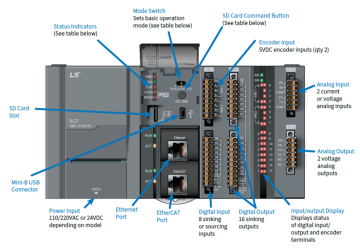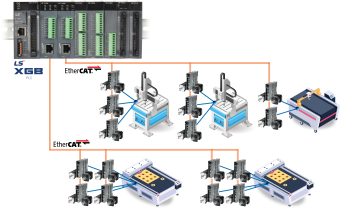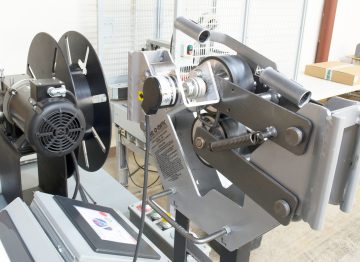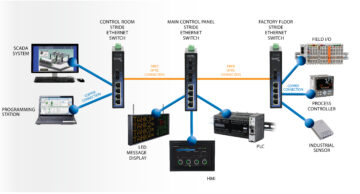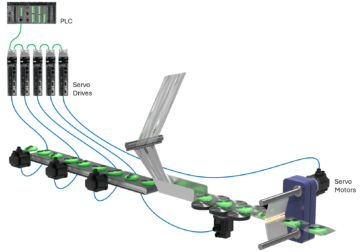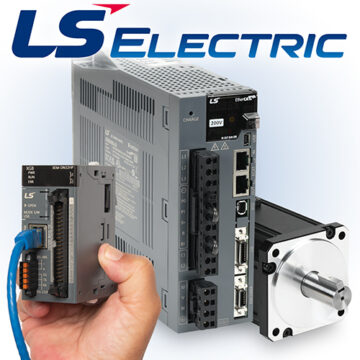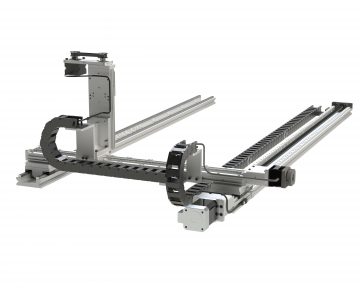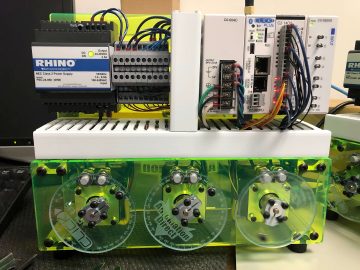Servo motors and drives use feedback to provide accurate position, speed, and acceleration control, making them ideal for demanding machinery and robotics applications. By Chip McDaniel, AutomationDirect Servo motor systems are a high-performance motion control technology, able to execute complex motion profiles while delivering high torque output, beyond the capabilities of typical direct current (DC)…
Process-enabled motion controllers and motion-enabled PLCs give OEMs the flexibility to optimize design and performance. By: Kevin McClelion and Joe Scoccimaro, AutomationDirect There was a time when designing machines that included motion control followed a standard architecture. The PLC handled basic machine control and a dedicated motion controller managed the motion axes. Today, the trend…
The EtherCAT protocol is a high-performance and cost-effective Ethernet networking technology, providing a versatile solution when EtherNet/IP and PROFINET simply aren’t fast enough. By Joe Kimbrell, AutomationDirect Ethernet rapidly expanded into and throughout commercial information technology (IT) networking connectivity environments beginning in the 1980s, and it has experienced rapid performance advancements and adoption since then…
For determining the precise motion of industrial machinery and equipment elements, or servo motors, encoders provide a high-performance solution—but only if they are specified properly. By Joe Kimbrell, AutomationDirect Mechanical movement generated on automated machinery and equipment almost always needs to be monitored by sensors to provide a robust motion control solution. This is especially…
Once only suitable for sheltered office installations, Ethernet media and protocols can now efficiently serve and future-proof a variety of industrial applications. Once upon a time (think 1980s), Ethernet was a relatively specialized computer connectivity technology, administrated by experienced gurus under highly-controlled office settings. Since then, technology and performance have advanced incredibly, and much of…
Modern multi-axis servo systems require a network for coordination of all the various movements. EtherCAT provides a high-speed cyclic mode that can update all the servo systems on the network within a few milliseconds. EtherCAT multi-axis servo systems can be created using the LS Electric XGB PLC in conjunction with LS Electric iX7 servo systems…
EtherCAT, which stands for Ethernet for Control Automation Technology, is a high-performance industrial network protocol based on standard Ethernet. It’s specifically designed for real-time communication and deterministic data exchange, making it ideal for motion control applications like robotics, assembly lines, and packaging machines. Key Features: Motion Control using EtherCAT: Benefits of using EtherCAT for Motion…
Linear actuators, driven with servo or stepper motors, are an effective way to implement accurate automated machine motion. Chip McDaniel at AutomationDirect wrote an article for the January 2023 issue of Design World’s Linear Motion Tips. Titled A Straight Line to Effective Linear Motion, this article explains linear actuator technologies, and it shows how they…
Designers working on smaller automation systems can now take advantage of advanced yet economical motion control by using micro-PLCs and stepper motors. Conor Perry, Technical Product Manager for the HMI and CLICK product groups at AutomationDirect, wrote an article for the October 2022 issue of Applied Automation. Titled Micro-PLC Motion Control Made Practical, the article…
Electrical actuators are an efficient and accurate way to automate linear motion on machinery and equipment. Automated machinery and equipment frequently require linear physical movement. Sometimes the mechanisms most move a product-holding tray into position, while other times the movement is for performing a manufacturing function, like drilling, inserting, gluing, or taping parts. The motion…



